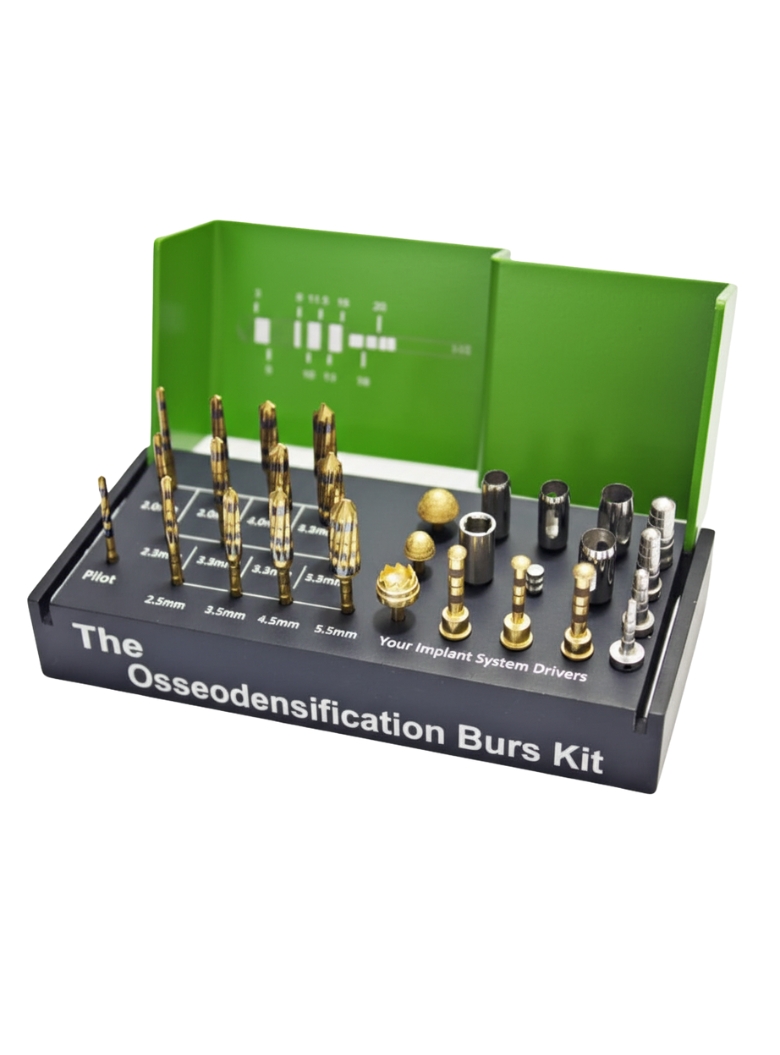Why Implantologists Prefer Osseodensification
If you’ve ever wondered why implantologists worldwide are switching from conventional drilling to osseodensification, the answer lies in one word — predictability.
Unlike traditional drilling that removes bone, osseodensification (OD) compacts and preserves it, creating a denser, stronger foundation for dental implants.
Recent evidence from a 2025 review in the Dentistry Journal shows that OD can increase implant torque and bone density by over 40%, enabling more reliable outcomes — especially in low-density (D3–D4) bone.
Let’s explore the five key reasons experts prefer this technique and what it means for clinics, students, and modern implantology training.
1. Superior Primary Stability and Insertion Torque
Clinical studies show up to 45% higher insertion torque compared to conventional drilling.
That means implants placed with OD achieve stronger anchorage from the start — a critical factor in early-loading protocols.
Average insertion torque: >40 N·cm vs. 20–30 N·cm with standard drilling.
ISQ (Implant Stability Quotient) values rise by 3–10 units.
Enables immediate loading in up to 78% of cases.
Why it matters:
Higher primary stability = less micromovement, fewer early failures, and greater confidence to load implants earlier.
In low-density bone (Misch D3–D4), this difference can mean the success or failure of a case.

2. Enhanced Osseointegration and Bone Density Formation

Osseodensification improves both microstructure and biology.
Instead of cutting bone, OD burs compact trabeculae outward — retaining autogenous bone chips that act as natural graft material.
BIC (Bone-to-Implant Contact): ↑ 12–28%
BAFO (Bone Area Fraction Occupancy): ↑ ~11%
Healing: Faster and denser mineralization in 4–12 weeks
This densified bone shows better vascularization, maintaining medullary channels for healthy angiogenesis and faster recovery.
In short:
OD doesn’t just prepare the site — it regenerates it.
3. Clinical Versatility Across All Bone Types
Whether you’re treating a young patient with strong cortical bone or managing an atrophic posterior maxilla, OD adapts.
Works across Misch bone densities I–IV
Allows ridge expansion up to 2–3 mm without fracture
Ideal torque control range: 35–65 N·cm, adjusted per bone type
Example:
In D3 bone of the posterior maxilla, OD can expand the ridge by 1–2 mm safely, eliminating the need for grafts in many cases.
This versatility makes OD one of the most universally adaptable implant site-prep methods in modern practice.

4. Minimally Invasive Alternative to Bone Grafting and Sinus Lift Procedures
Traditional grafting and lateral sinus lifts can be complex and time-consuming.
With OD, surgeons can achieve ridge expansion and transcrestal sinus elevation through a single, less invasive approach.
Zero to <2% sinus-membrane perforations in clinical trials
Surgical time reduced by 15–20 minutes on average
Lower postoperative pain and morbidity
Predictable vertical bone gain of 3–5 mm without grafting
For patients, this means fewer appointments, faster recovery, and lower costs.
For clinics, it translates to shorter chair time and improved patient satisfaction.

5. Higher Long-Term Predictability and Patient Satisfaction
Long-term data are still emerging, but current results are highly promising.
Across reviewed studies, complication rates remain below 5%, even in patients with osteopenia, osteoporosis, or systemic conditions.
Why patients love it:
Shorter healing times
Immediate function
Less postoperative discomfort
Why clinicians trust it:
Lower early-failure risk
Consistent results in difficult bone types
Enhanced confidence during immediate loading
Osseodensification represents not just a procedural upgrade — it’s a shift toward tissue-preserving implantology.
Final Takeaway
Implant dentistry is evolving toward precision and preservation.
Evidence confirms that osseodensification provides measurable advantages in stability, bone regeneration, and patient comfort — all with fewer complications.
If your clinic or training institute wants to stay ahead of this evolution, now is the time to integrate OD into your workflow.
💡 Explore Further
Discover the complete Osseodensification Kit by Hamsan Surgical — engineered for predictable performance, efficient irrigation, and smooth torque control.
Build stronger implants. Shorten surgical time. Enhance every outcome.

Best Osseodensification Burs Kit
Osseodensification Burs Kit designed for dental implant placement, featuring tapered...

The Osseodensification Burs Kit
Our Osseodensification Burs Kit, meticulously designed with precision sizes, employs...


